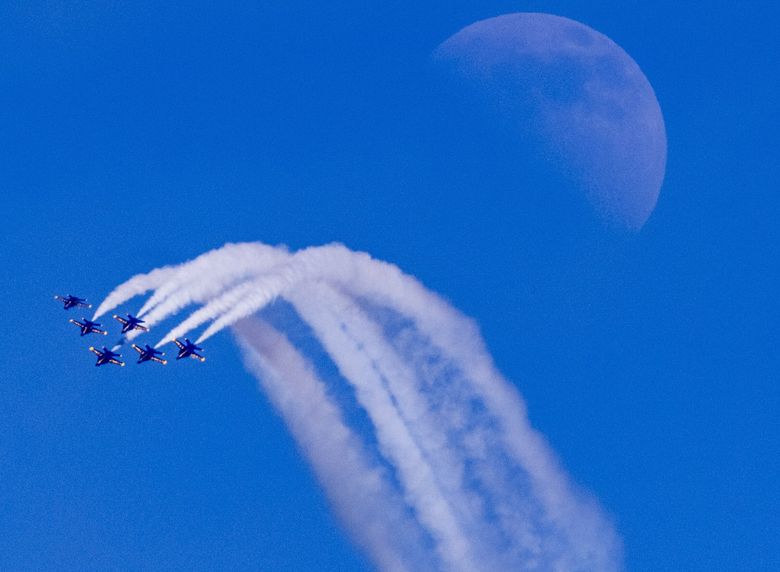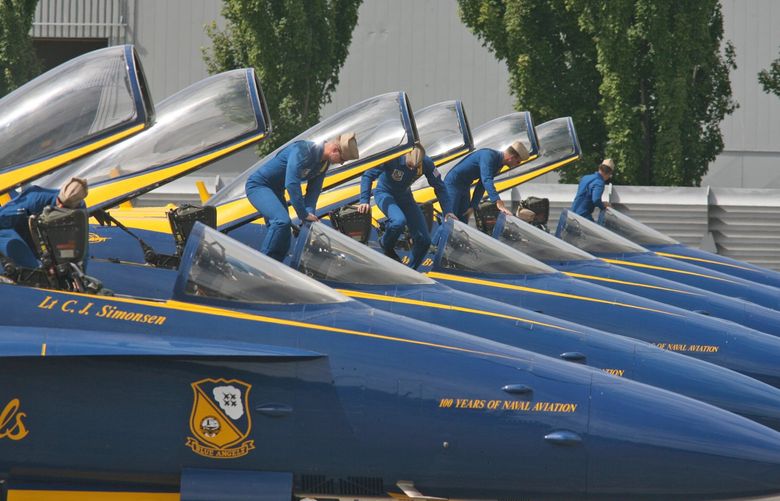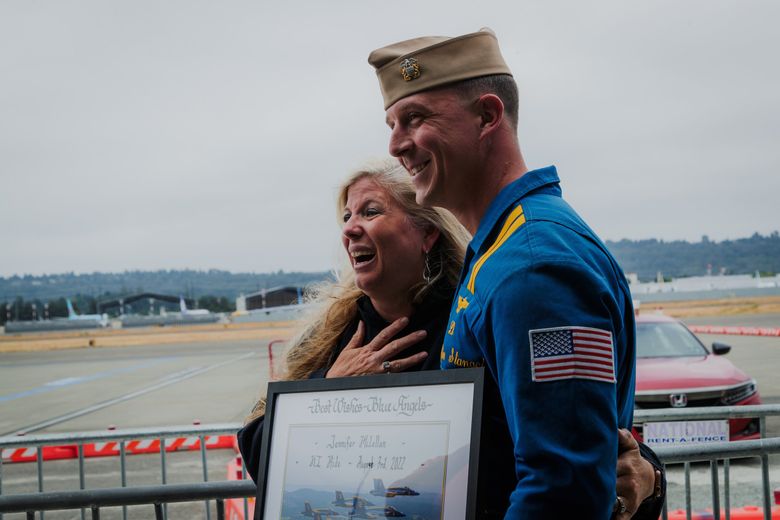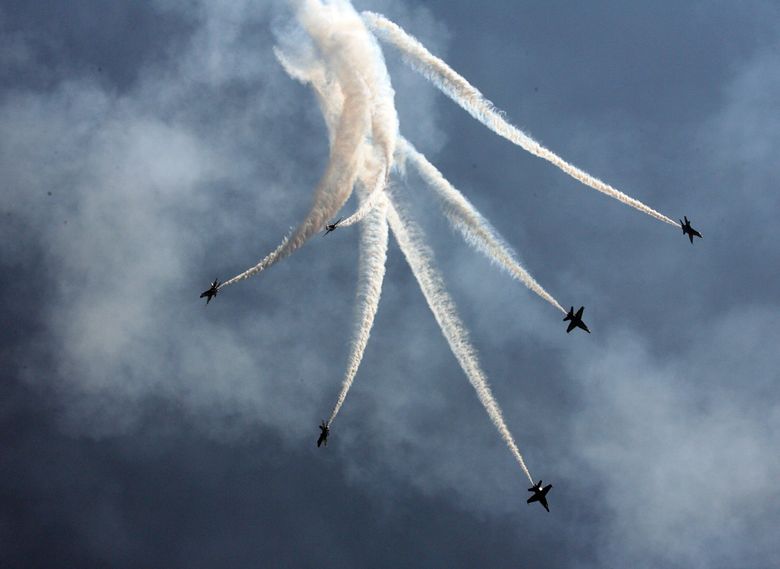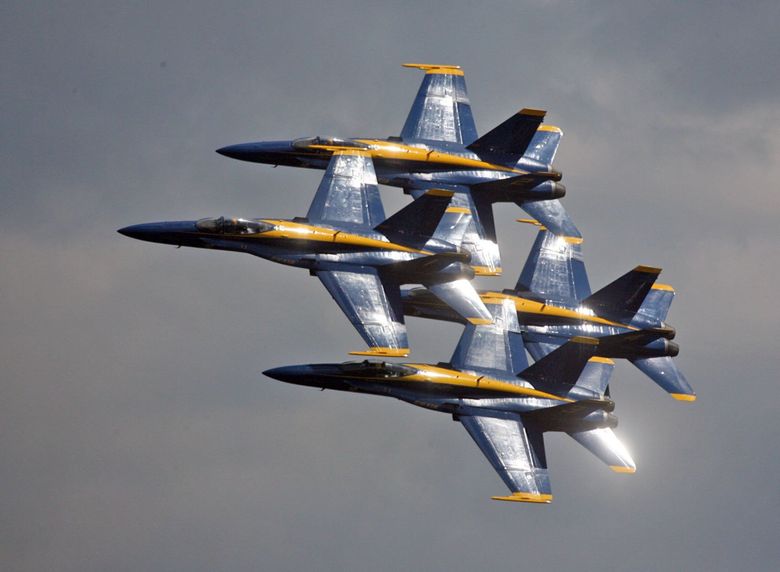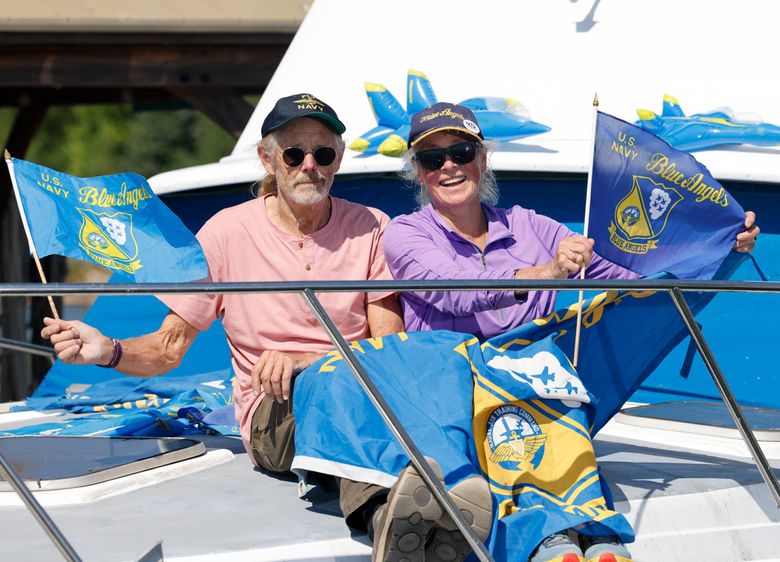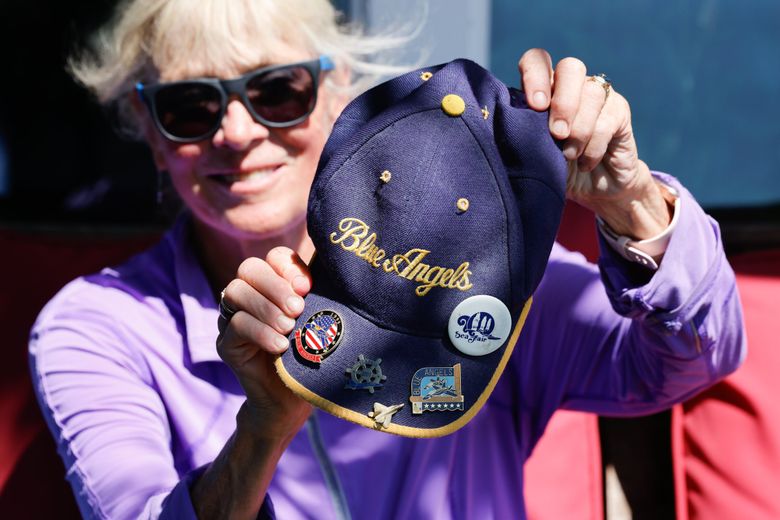The Navy’s Blue Angels have been performing their roaring aerobatic flight demonstration at the Seafair Air Show since 1972. It’s a Seattle summer tradition: Paired with the Seafair Cup hydroplane races that began in 1951, the skillful display of piloting is arguably the climax of Seattle’s marquee summer festival.
During the Blue Angels’ adrenaline-pumping show over Lake Washington, thousands of spectators watch six jets rip through the air at up to 700 mph, flying as high as 15,000 feet and as low as 50, sometimes within 18 inches of each other’s wingtips. Watching the Blue Angels perform is like seeing “artists at the highest level of their craft doing ballet with jets,” said Austin Hulbert, a former Navy pilot who “rushed” the Blue Angels but did not join.
But not everybody loves the Angels, doubtlessly the loudest part of Seafair. While some Seattleites circle this aerial event on their calendar every August, others decry the show as a gaudy flash of American military might.
And it’s not just the public that has mixed opinions (and misconceptions) about this squadron. I would know: I was a Navy helicopter pilot, so I’m aware of both the hype around the Angels and the perception, held by some in the military, that this group is more about flash than substance.
Approaching the 2024 Seafair Air Show, we pulled back the curtain: Who are the Blue Angels? What does it take to become one — and what is their mission?
Becoming a Blue Angel
You likely know the Blue Angels for their death-defying Seafair stunts, like the Delta Breakout, when fighter jets scream straight toward the crowd at nearly 400 mph, only for the jets to pull up at the last second.
Mastering these maneuvers requires serious training.
From January to March, the Blue Angels train in El Centro, Calif. They fly two to three training flights per day, six days a week. For those three months, the team does three things: eat, sleep, fly.
As the pilots perfect their routine, their bodies take a beating. The Blue Angels’ F/A-18 Super Hornet cockpits are rigged with a spring control stick, which requires an exhausting 40 pounds of pressure to fly. That means a lot of time in the gym doing bicep curls. Since their performances are scripted and G-forces are predictable, the Angels don’t wear G-suits. Instead, they practice breathing and tensing techniques so they don’t pass out midair.
The air show season then stretches from March to November, with the Angels flying 60 shows in 32 cities. They practice on Tuesdays and Wednesdays, fly to a given city on Thursdays, practice there on Fridays, then perform on Saturdays and Sundays. Mondays are the team’s “weekend.” Rinse and repeat.
Additionally, “there are 40 to 50 service events annually,” said Chief Michael Russell, the Blue Angels service events coordinator. The Angels will visit local hospitals and schools, hoping to inspire patients and young people, particularly those who face seemingly impossible challenges.
Yes, the Blue Angels are known for their stunts. But in reality, it’s a job that largely has to do with politics and looking the part. The team travels more than 300 days annually, flying jets and shaking hands.
That’s why the process for joining the Blue Angels isn’t what you might think. For one, applicants must pass a tough 40-pound strength test to become a Blue Angel — but a formal flight test is not required.
Navy officers with 1,000 flight hours — seven years or more into their career — are eligible to apply to become one of the six Blue Angels demonstration team members. A pilot’s ability to fly is judged on their aerial reputation, and candidates go through a rush process to see if they can cut it on a social level, too.
It’s like “a fraternity rush,” said Hulbert, who rushed the Blue Angels in 2014 but was not selected. Lt. Cmdr. Katlin Forster, a former Blue Angels flight navigator, added that the rush season was comparable to “first date vibes.”
Blue Angels rushees are invited to shadow the team and crew members across two to three air shows, fitting those dates into their active duty training schedules. The mission is to make an impression, because “the last thing you want is someone not to remember who you were,” Hulbert said.
Without a flight test, Hulbert’s previous bosses and fellow aviators were asked to answer questions about his flight skills. They were asked about Hulbert’s personal reputation, too, which he admits was “the quintessential frat guy jet pilot only interested in chasing women.”
Hulbert cleaned up his reputation enough to be invited back as a Blue Angels finalist at the Pensacola Beach Air Show in Florida in July 2014. By that weekend, the initial group of 56 had been trimmed to seven pilots fighting for three roster spots.
In Pensacola, Hulbert had a medical screening and the dreaded 40-pound stick test. (To simulate the cockpit’s control stick, pilots spend 20 minutes at a rowing machine, pulling and releasing a cord to adjust the weights to different heights, simulating the tension of handling the control stick.) That is the only physical test to join the Angels. Otherwise, Hulbert was fitted for his sleek royal-blue flight suit, plus flight boots, gloves and a flashy yellow helmet — and later had the daunting formal interview.
Hulbert sat at the head of a long table facing the commanding officer and the other Blue Angels demonstration pilots. The remainder of the Blue Angels officers lined the sides of the room; everyone is in their flight suit except the rushee. For about 20 minutes, questions were fired from all angles, mainly about Hulbert’s reputation. (For example: “How do we know you aren’t going to use this as a way to pick up chicks?”)
In the interview, Hulbert recalled how inspired he was as a child seeing the Blue Angels and how he hoped to bring that inspiration to others.
In the end, Hulbert was not selected. Still, he admires the Blue Angels, like most jet pilots do. And though auditioning to become a Blue Angel differs from the Navy’s standard practice for assigning a duty station, Hulbert and Forster agreed that the rush system is necessary to build a cohesive team that has the stamina for socializing with the public.
“They are artists performing at the highest level of their craft,” Hulbert said of the Blue Angels, “while holding the highest level of professionalism.”
Why the Angels fly
Though the Blue Angels are respected in the military for their flying skills, time spent learning and repeating aerobatics means these pilots forfeit tactical military prowess. That means playing catchup on warfighting tactics that their military counterparts are practicing daily.
To pilots enduring the grueling training required for a typical military mission, the Blue Angels may be perceived as excellent pilots whose main role is to shake hands and kiss babies. That is: They’re not a tactical military unit, but rather a symbolic one. Their mission is to inspire people to achieve the impossible — by being model men and women on the ground and in the air.
“If we fly high, no one’s going to see us,” said Maj. Joshua Soltan, of Spokane, a Blue Angels C-130 pilot, “or see what the Blue Angels actually represent.”
Every Blue Angel interviewed for this story, past and present, adamantly believes in the mission. But no data exists that can measure the team’s impact or influence. A recruitment poll can’t show the lives they may have impacted, nor the joy they have brought to spectators, or how they may have pushed another person to be extraordinary.
That high-minded, flag-waving aspiration might cause some to recoil. But even non-Angel military members have found inspiration from the elite air show squad.
Lt. Nick Taylor, of Arlington, is stationed at Whidbey Island Naval Air Station. The Blue Angels didn’t convince Taylor to join the Navy, but they did inspire him to pursue airborne excellence.
Taylor recalled how he would “watch them ripping around Pensacola in tight formation” when he was in flight school in Florida. The Blue Angels “confirmed for me that I wanted to work as hard as I could in flight school to be able to fly fighter jets for a living,” Taylor said.
Meanwhile, for civilians on the ground in Seattle, there have been mixed views on the Blues for decades.
Merlin Rainwater, who has lived on Capitol Hill for 44 years, argues that the tradition should be retired. Calling the air show “a glorification of war,” she considers skipping town the first weekend of August each year.
Raised a pacifist in Edmonds, Rainwater has been railing against the Blue Angels since moving to Seattle. Starting in 1986, she has written letters to The Seattle Times advocating for the retirement of the Blue Angels. Beyond the noise, Rainwater counts among her grievances the forced entertainment of watching warplanes; consumption of fuel; a greenhouse gas effect that “leaves a visible haze in the sky for days”; and taxpayer expense.
Lifelong Rainier Beach resident Leslie Crow, on the other hand, treats Seafair like a holiday. Crow and her husband, Terry Stipe, line the entryway to their home with Blue Angels flags in preparation for the air show each year.
Truly, Crow and Stipe could fill a museum with their tattered Blue Angels flags and pins. I know this because I’m staying in their guesthouse for the summer.
The couple have fond memories of sleeping on the beach at Seward Park the night before big Seafair events, then spending the next day reveling in the sun and the air show. To Crow, the Blue Angels represent “childhood, summer, neighborhood and community. It’s just a positive energy.”
Beyond summer fun, the air show has had a real impact on Stipe and Crow.
The couple’s only son, Sascha, didn’t become a Blue Angel, but he did become a Navy pilot. Given all the Blue Angels memorabilia in Sascha’s childhood home, it’s no surprise the fanfare rubbed off. You can bet Stipe and Crow will be out on Lake Washington next weekend, listening for the Blue Angels reaching near Mach 1 speeds, emitting what Crow called “the sound of freedom.”

